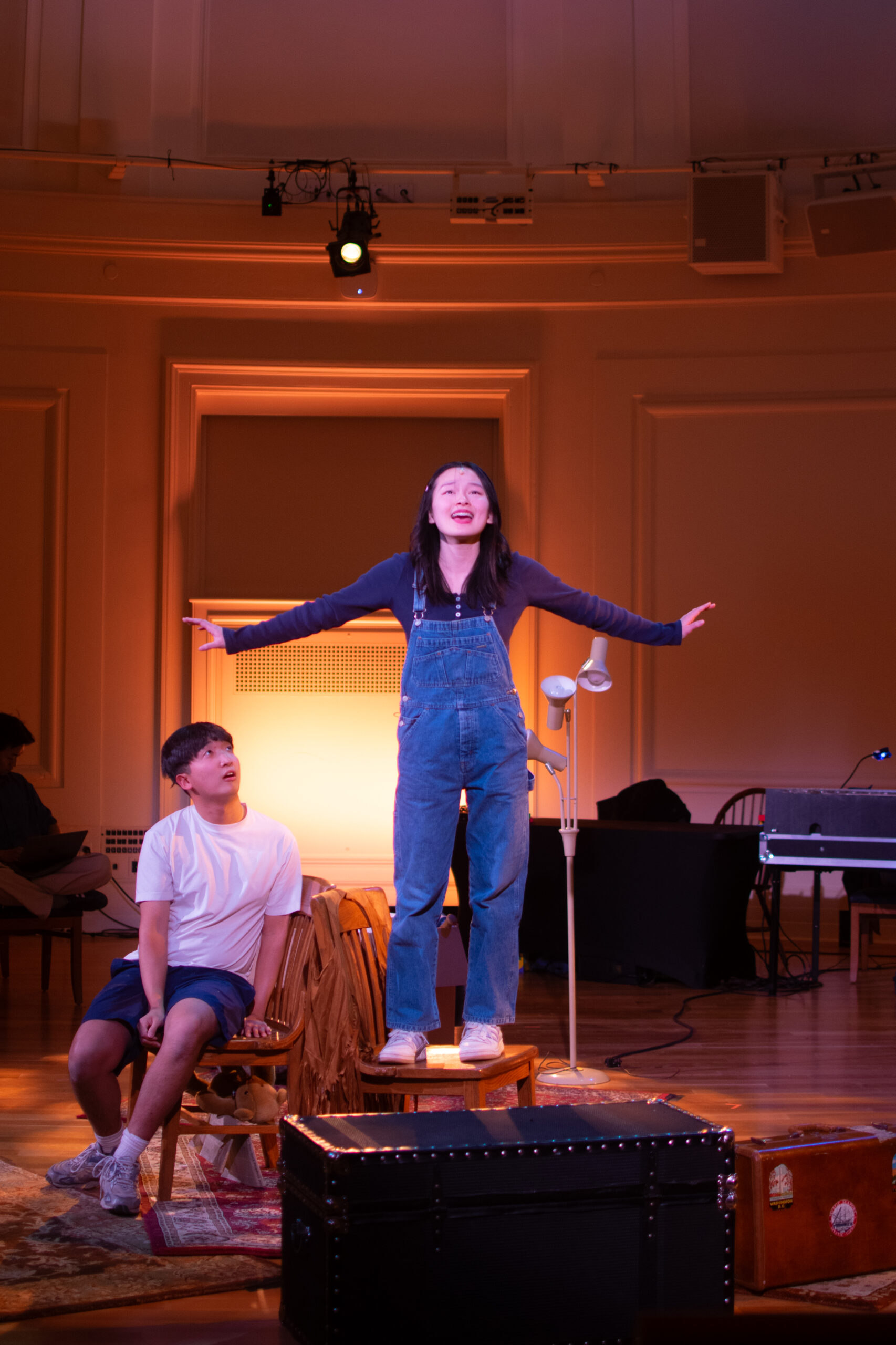REVIEW: “john & jen” teaches us to let go and love courageously
The show, a production by the Asian American Collective of Theatermarkers, premiered on April 2 at The Dome in Schwarzman Center.

Courtesy of Melany Perez
It’s hard to find a show with robust acting, stage design and dramaturgy. Usually, shows accomplish one, if not two, of these aspects at most. “john & jen” masterfully captures all three.
Directed by Alastair Rao ’26 and produced by Annabelle Hee ’26 , the two-hander musical ran at Schwartzman’s Dome from April 2 to 4. Starring in the eponymous roles were Sally Zheng ’28, as Jen, and Sam Ahn ’25, as John. Written in the 1990s, the story — divided into Act 1 and Act 2 — spans the decades in between the 1950s and 1990s.
The story follows the two siblings, whose close bonds are forged in the face of their G.I. father’s violence and neglect. Jen vows to protect her brother; a promise that begins to erode when Jen leaves for college. As time passes, distance grows between the two, and hostility begins to mount.
Bitter feelings still linger between the two when John dies while serving in the Vietnam War. Three decades later, Jen is a single mother raising her son, John. In her parenting of John Jr., Jen grapples with the unresolved guilt and remorse she feels towards her dead brother.
Putting on a production at the Dome is no easy feat. For the most part, “john & jen” adeptly took on the various sound and stage design challenges.
As the stage is entirely surrounded by audiences, productions must also account for the fact that actors, for the most part, can’t leave the stage and remain entirely visible throughout the show.
The two leads — Zheng and Ahn — took on this challenge with seeming grace and ease. There was never more than a five-minute period in which the actors showed their backs to a particular side of the audience — an impressive feat from Zheng and Ahn, as well as Rao.
There were some obstacles, however, that the cast and crew were unable to evade.
For a production featuring two extremely strong singers, you could barely hear them. At times, it seemed as if Zheng and Ahn were battling with the pit orchestra to be heard.
Especially for musicals that depend on the lyrics to move forward in the story, some important, or even just beautiful, lines were buried by the pit. This issue was especially apparent in “Bye Room,” in which John Jr. heads to college and waves his childhood room goodbye.
John Jr.’s gleeful farewells — “Ciao fish! See ya teddy bear.” — musically overlaps with the sarcastic, bitter remarks — “Bye, deafening music that pounds in my head!” — from Jen, who isn’t ready to send her only child to camp.
This scene is meant to be fun and riddled with tension — emotionally and musically – but, with the overbearing pit orchestra and flashing green-and-red lights, the scene verged on entropy.
The show, in which the two actors play characters across various stages of life or even take on two separate roles, requires extra effort on the part of actors and designers to fully convey the gist to viewers.
Ahn — who plays John Sr. and John Jr. — was especially brilliant in expressing both the bitterness of the former and gleeful, carelessness of the latter character.
Ever the veteran actor, Ahn switched deftly between these two roles; at times, his play of being a frightened middle-schooler (John Jr.) who hates playing baseball was so compelling that he, a graduating senior, truly seemed to be younger than Zheng, a current first year.
The world-building of the play was also supported by the work of stage and props designer Mateo Balbarin ’25 and Robert Gao ’27.
The use of various props was effective and economical. The long, rectangular chest doubled as a platform for the actors to stand on, as well as the flag-draped coffin that signifies John Sr.’s death. A nearby box with clothes and other props becomes a closet for Jen in “Trouble with Men.”
Even with a barely-changing scene and a modest set-up, the stage propelled the story forward in time and transported viewers to different places.
The show was exceptionally staged and performed. But this is not a rarity among Yale productions, which frequently boasts talented actors and designers.
What really made “John and Jen” a stand-out show was its dramaturgical basis.
To those who are familiar with the show, the decision to select “John & Jen” for an AACT production, and feature an all-Asian cast, is a curious one. Put bluntly, there’s nothing “Asian” about the play — or at least on the surface.
From its show poster, which depicts two small, white children playing on the seashore, to references of the stoic, all-American veteran father, the story of “John & Jen” seems to live exclusively in the white American imagination.
Yet, in a brilliant move, the show connects the show’s themes of misplaced love, intergenerational trauma and familial guilt to stories that read all too familiar to children of the Asian diaspora.
As the eldest sister, Jen grows up faster than the average child in order to fill in her parents’ empty shoes — orchestrating visits from Santa and helping John with his homework — and to protect her younger brother from their father’s violence.
In this way, Jen embodies the sacrificial, eldest child of the Asian immigrant family who shields their youngest siblings from the inexpressive, or the ill-expressed, love of their parents.
The relationship between Jen and John, the ways in which these two love and fail each other, doubles as an astute commentary on the dynamics within Asian American, Asian immigrant families.
Jen, who promises John that they will always be there for each other, ultimately leaves for college (“Timeline”). As Jen revels in the newfound liberties of living away from home and John looks to his father to become a “man,” the two siblings grow farther and farther apart.
Fast-forward to 1970: John is 18, and Jen is 24. Six years have passed, and much has changed. John now serves in the U.S. Navy; meanwhile, Jen is staunchly against the war and plans to move to Canada with her draft-dodging boyfriend.
It’s evident that John and Jen are experiencing two different Americas amidst the brewing sociopolitical changes. Act I ends with a furious argument between the two, in which both condemn the other for their political outlooks and exchange hate-filled words.
This scene is reminiscent of the complicated and multi-faceted political identities and spaces that all exist under the umbrella of “Asian America” — from the Asian Americans who rebuff affirmative action to those who dutifully campaign alongside progressives in their local elections.
The greatest irony is that all of these individuals probably come home to eat dinner at the same table as part of the same family. In this way, Jen and John are apt metaphors for the state not just of the U.S. today, but the political spectrum of Asian America.
Additionally, as Jen attempts to compensate for the guilt she feels towards John Sr., the show is a painful reminder that love does not exist in generational equations or zero-sum games.
Jen attempts to raise John Jr. to be a replica of his uncle; this time, however, Jen is determined to love John right, protect him from the world and keep her promise. But love doesn’t work in the ways we want it to; love that is lost cannot be as easily made up.
Towards the end of the play, Jen realizes that there is no way to make up for the harm she has incurred to her brother.
Again, Jen’s fruitless attempts to live out unrealized aspirations and dreams through her son is a familiar tune to Asian immigrant families.
For instance, burned by experiences with poverty or political instability, Asian immigrants project their own desires and “what-could-have-beens” onto their children, not realizing that their children chase after different dreams.
What is so beautiful and dramaturgically effective about “john & jen” is that, in Jen, audiences see the eldest immigrant sibling who struggles with their filial obligations and ultimately leaves behind a less-than-perfect family. In Act II, Jen becomes the loving Asian immigrant parent who inadvertently produces the same wounds inflicted onto them.
In John, audiences locate the hurt of being left behind, as well as the child-of-immigrants pressure to live up to another person’s dreams.
In the musical’s final song, “Every Goodbye Is Hello,” John, Sr. and Jr., and Jen finally acknowledge their less-than-perfect attempts at love. Jen waves her dead brother goodbye and waves hello to her son, with whom she prepares herself to love and live in the present.
Especially as generational trauma is a specter that seems to haunt many Asian families, this final song is a reminder to all — Asian immigrant parents, eldest siblings, youngest children — to let go of the pressures to right historical wrongs and rack up the courage to love in the present.







